Graceful, sharp-eyed, and lightning-fast—the Shikra (Accipiter badius) is one of India’s most widespread and adaptable raptors. Commonly seen gliding through gardens, groves, and urban skies, this small hawk is an apex aerial predator in its own right. Despite its modest size, the Shikra embodies the stealth and precision that define birds of prey.
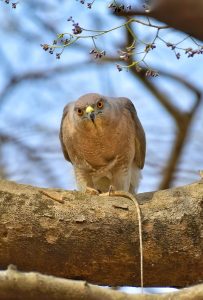
Whether perched motionless in a mango tree or swooping down on an unsuspecting lizard, the Shikra is a silent predator that commands attention. This article explores its identification, behavior, hunting techniques, habitat, and cultural relevance—while also uncovering the role this fascinating raptor plays in India’s diverse avian ecosystem.
Suggested Read: Indian Peafowl – The Majestic Bird
Identification: How to Recognize a Shikra
The Shikra is a small to medium-sized hawk, often confused with lookalikes like the Common Hawk-Cuckoo due to similar plumage. But a trained eye can easily distinguish it through key field marks:
| Size | 26–30 cm in length; wingspan of 50–60 cm. |
| Plumage | |
| Upperparts | Slate-grey or bluish-grey back and wings. |
| Underparts | Pale with fine rufous barring on chest and belly. |
| Eyes | Striking red to orange-red eyes in adults (yellow in juveniles). |
| Tail | Medium length with 3–4 narrow black bands and rounded tip. |
| Legs and Feet | Bright yellow, strong talons for gripping prey. |
| Beak | Strong, hooked and adapted for tearing flesh. |
Sexual dimorphism is subtle—females are slightly larger and bulkier than males.
Shikra’s Behaviour and Ecology
A Silent and Swift Hunter
The Shikra is a quintessential ambush predator. It perches silently, often near dense foliage or on an open branch, scanning its surroundings with intense focus. When prey is spotted, it launches a rapid, surprise attack, often too swift to follow with the naked eye.
Diet of Shikra
Shikras are carnivorous and highly opportunistic. Their diet includes:
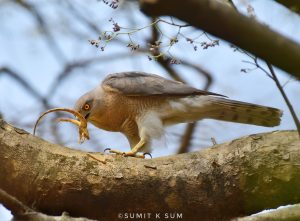
- Lizards (especially garden lizards and skinks)
- Small birds
- Rodents
- Insects (grasshoppers, large beetles, wasps)
In urban areas, they are known to raid bird nests and catch pigeons or mynas in mid-air.
Also Read: Spotted Owlets
Breeding and Nesting in Shikras
The breeding season ranges from March to June, though slight regional variation exists.
- Nest: A platform of twigs lined with green leaves, usually in tall trees like neem, mango, or peepal.
- Clutch Size: 2 to 5 pale bluish-white eggs.
- Parental Care: Both sexes participate in nest defense, incubation, and feeding, though females do most of the incubation.
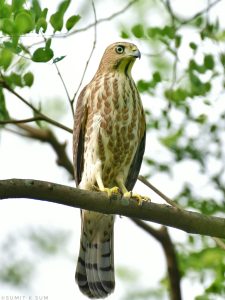
Shikras are territorial during breeding, often seen aggressively chasing away other raptors or large birds that enter their domain.
Distribution and Habitat of Shikras
Geographic Range
The Shikra is widely distributed across:
- India, Nepal, Bangladesh, and Sri Lanka
- Parts of West and Central Asia
- Extends into Africa under subspecies recognition
Habitat Preferences
- Urban parks and gardens
- Deciduous and mixed forests
- Scrublands and agricultural areas
- Edges of wetlands and plantations
Their remarkable ability to adapt to human-altered landscapes makes them one of the few raptors thriving in Indian cities.
Shikra vs. Lookalikes
Common Hawk-Cuckoo:
- Mimics the Shikra in appearance.
- Lacks strong talons and hooked beak.
- Calls “brain-fever,” unlike Shikra’s “kik-kik-kik” alarm call.
Read in Detail: Common Hawk Cuckoo
Eurasian Sparrowhawk:
- Found in parts of north India during winter.
- Larger with heavier barring and broader wings.
Identifying the Shikra correctly contributes to broader awareness of urban raptor diversity.
Vocalizations of s Shikra
The Shikra is usually quiet, but during the breeding season or when alarmed, it lets out a sharp, repeated:
“kik-kik-kik-kik”
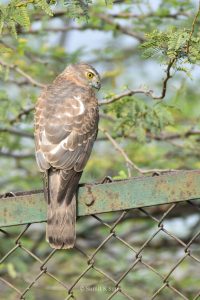
It may also give a soft chittering or churring call when disturbed near its nest.
Cultural and Ecological Importance of Shikra
Historically, the Shikra was trained for falconry, especially in the Mughal era. Its name itself comes from Persian/Urdu “شِکره” (shikra), meaning hunter.
In ecosystems, Shikras play a crucial role in pest control, preying on rodents and insects in agricultural zones. Their presence is often a healthy sign of biodiversity—even in city parks.
Read in Detail: Indian Paradise Flycatcher
Conservation Status of Shikra
- IUCN Status: Least Concern
- Population Trend: Stable
The Shikra has benefited from its adaptability, but like all raptors, it faces threats from:
- Habitat destruction
- Poisoning from rodenticides
- Electrocution from power lines
Urban greening efforts and awareness of raptor importance can help conserve these stunning predators.
A Hunter’s Companion: The Shikra in Falconry Traditions
The Shikra’s very name is a clue to its cultural lineage. The word “Shikra” is derived from the Persian, which stems from shikaar—meaning “hunt.”
In Medieval India, the Shikra was a prized bird in falconry, the ancient art of hunting with trained birds of prey. Emperor Akbar’s court chronicles, particularly the Ain-i-Akbari, reference the use of Shikras alongside larger falcons like the Shaheen. Though smaller and less imposing, the Shikra’s agility and responsiveness made it a favorite for hunting small game.
It was often the first bird trained by apprentice falconers due to its manageable size and tameable nature, earning it a reputation as the “sparrowhawk of the common man.”
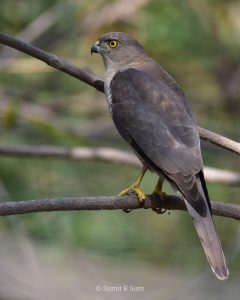
A Symbol in Folk Wisdom
In Indian rural lore, the Shikra often appears as a weather prophet and a harbinger of activity. Farmers sometimes interpret its sudden flight across fields or its distinctive “kik-kik-kik” calls as signs of an approaching change—be it rain, heat, or harvest readiness.
In some traditions, spotting a Shikra on a tree before heading out for the day is considered lucky, especially among bird-keen communities in Rajasthan and Madhya Pradesh. Conversely, its appearance near poultry or nests is viewed with suspicion due to its hunting nature.
Shikra in Language and Idiom
While not as extensively featured in classical Indian poetry as songbirds, the Shikra finds mention in regional proverbs and idioms. In Hindi and Urdu, phrases such as:
“Shikra ki nazar” — “Eyes like a Shikra”
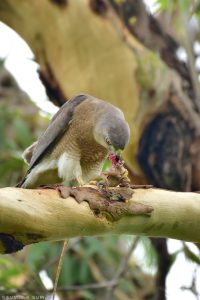
Used to describe someone with sharp perception or vigilance.
In some dialects, a jealous or controlling lover is referred to metaphorically as a Shikra—circling and watching, swift to act.
Literary Mentions and Metaphorical Usage
The Shikra may not have the emotional weight of the papiha (brainfever bird) or the koel in literature, but it is often used as a metaphor for swiftness, alertness, or aggression.
In modern nature writing and poetry, the Shikra increasingly represents urban wildness—a symbol of how raptors have quietly adapted to concrete jungles, thriving where few large birds can.
Writers like Salim Ali and M. Krishnan have admired the Shikra for its elegance and efficiency, often citing its role as a misunderstood yet vital predator in suburban and rural ecosystems.
The Shikra in Modern Symbolism
In today’s urban India, the Shikra has found new symbolic ground. It features in:
- Conservation campaigns as a sign of balanced biodiversity.
- Birdwatching literature as a “gateway raptor” for new enthusiasts.
- Environmental storytelling as a reminder that the natural world survives even in crowded city parks and apartment gardens.
Its stealthy presence makes it a powerful symbol of the wild hiding in plain sight.

The Shikra is more than just a common hawk—it is a symbol of adaptability, precision, and ecological balance. Whether you’re in a bustling city or a quiet village, a glimpse of this bird of prey on a morning walk reminds us that nature persists even in the most human of spaces.
For birdwatchers, photographers, or anyone curious about India’s rich avian life, the Shikra is a perfect starting point to appreciate the power and beauty of raptors.
